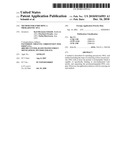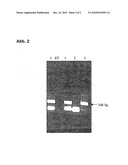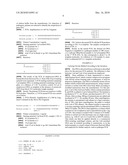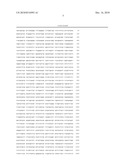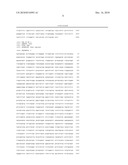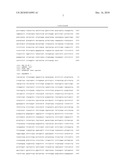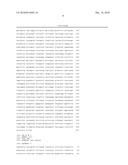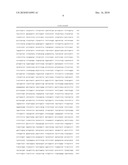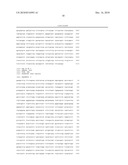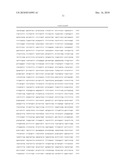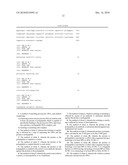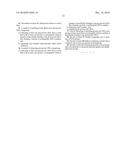Patent application title: METHOD FOR ENRICHING A PROKARYOTIC DNA
Inventors:
Karl-Hermann Schmidt (Stadtroda, DE)
Eberhard Straube (Jena, DE)
Stafan Russwurm (Jena, DE)
IPC8 Class: AC12Q168FI
USPC Class:
435 6
Class name: Chemistry: molecular biology and microbiology measuring or testing process involving enzymes or micro-organisms; composition or test strip therefore; processes of forming such composition or test strip involving nucleic acid
Publication date: 2010-12-16
Patent application number: 20100316993
Claims:
1. A method of enriching procaryotic DNA, said method comprising:a)
contacting at least one procaryotic DNA in solution with at least one
protein or polypeptide which is capable of specifically binding to the
procaryotic DNA, thus forming a protein or polypeptide DNA complex, andb)
isolating or enriching said complex.
2. The method of claim 1, wherein the isolating or enriching is followed by a step of separating the DNA and the protein or polypeptide.
3. The method of claim 1, wherein the protein or the polypeptide is coupled to a carrier.
4. The method of claim 3, wherein the protein or the polypeptide is coupled directly to said carrier.
5. The method of claim 3, wherein the protein or the polypeptide is coupled to the carrier via an antibody directed against the protein or the polypeptide.
6. The method of claim 3, wherein the carrier is provided as a matrix, as microparticles or as a membrane.
7. The method of claim 1, wherein isolating or enriching is effected by means of an antibody or antiserum directed against the protein or polypeptide.
8. The method of claim 1, wherein the isolating or enriching is effected by means of electrophoresis.
9. The method of claim 1, wherein the protein or the polypeptide is an antibody or antiserum directed against non-methylated CpG motifs.
10. The method of claim 1, wherein the protein or polypeptide is encoded by the TLR9 gene or by the CGBP gene.
11. The method of claim 10, wherein the protein or polypeptide is encoded by a cDNA with a sequence having a homology of at least 80% to SEQ. ID NO. 2.
12. The method of claim 10, wherein the protein or polypeptide is encoded by a cDNA with a sequence having a homology of at least 80% to SEQ. ID NO. 3 or a fragment thereof, or cDNA having a homology of at least 80% to SEQ. ID NO. 4 or a homology of at least 80% to SEQ. ID NO. 5.
13. The method of claim 1, wherein the solution contains eukaryotic and procaryotic DNA.
14. The method of claim 13, wherein the solution is a body fluid.
15. A method of purifying body fluids from procaryotic DNA comprisinga) contacting at least one procaryotic DNA from a body fluid with at least one protein or polypeptide which is capable of specifically binding to the procaryotic DNA, thus forming a protein or polypeptide DNA complex, andb) separating said complex extracorporally under sterile conditions.
16. A method of detecting procaryotic DNA comprisinga) contacting at least one procaryotic DNA from a body fluid with at least one protein or polypeptide which is capable of specifically binding to the procaryotic DNA, thus forming a protein or polypeptide DNA complex,b) separating said complex, andc) amplifying the procaryotic DNA.
17. A kit for detecting or enriching procaryotic DNA comprising at least one protein or polypeptide which is capable of specifically binding to the procaryotic DNA.
18. The kit of claim 17, further comprising one or more-sets of PCR primers.
19. The kit of claim 18 further comprising a carrier that is coupled to the at least one protein or polypeptide.
20. The kit of claim 19, wherein the protein or the polypeptide is an antibody or antiserum directed against non-methylated CpG motifs.
Description:
[0001]The invention relates to a method of enriching procaryotic DNA as
well as to a kit for carrying out said method.
[0002]Infections caused by bacteria are one of the most frequent causes of inflammatory diseases. For the prognosis of the clinical course as well as, in particular, for timely selection of
[0003]suitable therapeutic measures, early detection of the bacterial pathogens is of decisive importance.
[0004]In the detection of bacterial pathogens, use is made, above all, of different methods of cultivating cells. However, methods of molecular biology which are based on the detection of pathogen-specific nucleic acids have also become more important recently. In addition to the high specificity of these methods, mention must be made of the little time required as an essential advantage over conventional methods. However, the sensitivity of the detection of procaryotic DNA directly from body fluids and from test material that has not been pre-treated has hitherto been much too low as compared to the culture of microorganisms. An amount of nucleic acids of bacteria sufficient to detect pathogens directly from the test material that has not been pre-treated is achieved, if at all, in the region of the 16S-mRNA molecules. However, this requires that the bacteria to be detected be present in the metabolic phases and express sufficient 16S-mRNA.
[0005]This is usually not the case, in particular in patients who are subject to antibiotic therapy. Moreover, certain pathogenicity factors of bacteria are not expressed every time, although the corresponding genes are present in the bacterial genome. Therefore, the detection of the pathogenicity factors and resistance of bacteria at the chromosomal level is indispensable for the diagnosis of septic disease states.
[0006]This applies even more because, at this level, a distinction can also be made between pathogenic and commensal bacteria.
[0007]Most frequently, the detection of pathogen-specific nucleic acids is effected by amplification of the procaryotic DNA by means of the polymerase chain reaction (PCR) or the ligase chain reaction (LCR), respectively. The high specificity and fast availability of the results is contrasted by the susceptibility to interference or by strongly inhibiting factors of clinical samples.
[0008]In a conventional PCR detection method, successful detection of pathogens in the blood requires isolation of total DNA from at least 1 to 5 ml of blood. However, the total DNA concentration is then too high to be employed directly in a PCR reaction.
[0009]Things are different with regard to the blood culture for detection of sepsis pathogens. In this case, the lower detection limit is less than 10 bacteria per ml. This detection limit is presently achieved only by PCR protocols whose target sequence is in the 16S-RNA region and which are therefore dependent on the expression of said target sequence. Greater diagnostic reliability can be expected of PCR protocols which have their target sequences in the chromosome of the microorganisms. The expression behavior of different genes can be considerably changed or limited, especially under the influence of an ongoing antibiotic therapy, even if the antibiotic used is ultimately not effective. This situation is often found particularly in intensive therapy wards, where most patients receive antibiotic treatment, thus not allowing to grow any relevant bacteria from blood cultures or other samples for this reason.
[0010]Due to insufficient sensitivity, the detection of pathogen-specific nucleic acids, without an amplification step by direct detection of procaryotic DNA (probe technique, FISH technique), is of diagnostic importance only at a sufficiently high germ number in the test material.
[0011]The essential problems of the detection of procaryotic DNA for identification of bacterial pathogens in body fluids consist, beside PCR-inhibiting ingredients in the test material, mainly in the excess of eucaryotic DNA versus procaryotic DNA. In this connection, competitive processes in DNA analysis as well as the low quantity of procaryotic DNA can be regarded as a hindrance to a qualitative and quantitative detection of pathogens.
[0012]The usual methods of DNA isolation enrich the total DNA of a body fluid so that the ratio of host DNA to microbial DNA may be between 1:10-6 and 1:10-8. This difference makes the difficulty in detecting microbial DNA in body fluids quite clear.
[0013]Therefore, it is an object of the present invention to provide a method of isolating and/or enriching microbial DNA, in test samples having a high content of eucaryotic DNA from patients with infections, for quick and easy detection of pathogens, said detection enabling early diagnosis of infections caused by bacterial pathogens.
[0014]According to the invention, this object is achieved by a method of enriching procaryotic DNA, comprising the steps of
[0015]a) contacting at least one procaryotic DNA in solution with at least one protein or polypeptide which is capable of specifically binding to procaryotic DNA, thus forming a protein or polypeptide DNA complex, and
[0016]b) separating said complex.
[0017]In this case, the term procaryotic DNA relates to both viral and bacterial DNA. Said DNA may be purified and dissolved again or may be present directly in the original source (e.g. body fluid, such as blood, serum, etc.).
[0018]Separation may be effected by means of different methods of isolating or enriching DNA protein complexes or DNA polypeptide complexes that are well-known to the person skilled in the art. In doing so, use will be made preferably of methods in which the DNA-binding protein is immobilized to a carrier matrix in order to enrich the DNA from the sample solution.
[0019]According to a preferred embodiment, the separation is followed by a step of separating the DNA and the protein/polypeptide. This may be effected, for example, by conventional methods of DNA purification which are known to the person skilled in the art. In the most simple case, the separation is based on the change in pH value or in the salt concentration (e.g. to 1 M NaCl) of the medium/buffer or on the addition of chaotropic reagents, etc.; i.e. suitable parameters which lead to the separation of the protein-DNA-complex. Such methods are known to the person skilled in the art.
[0020]According to a further preferred embodiment, the protein or the polypeptide is coupled to a carrier. This embodiment represents a particularly simple way of enriching procaryotic DNA, because the separation from the solution is particularly easy, for example by means of physical removal (e.g. by centrifugation) of the charged carrier(s) from the solution.
[0021]As the solution of the procaryotic DNA, any suitable solvent is basically suitable. However, the method is particularly useful for enriching procaryotic DNA from solutions which contain different biomolecular species, in particular different types of DNA. The invention preferably relates to a method of separating and enriching procaryotic or viral DNA and eucaryotic DNA from a mixture of procaryotic or viral DNA. In doing so, for example, the procaryotic DNA which is present in body fluids is separated from the eucaryotic DNA, by specific binding to the protein or to the polypeptide, and enriched. The procaryotic DNA enriched in this way facilitates detection of procaryotic pathogens with the help of molecular biology methods and can contribute to the diagnosis of diseases caused by pathogenic pathogens.
[0022]In particular, the embodiment according to which the DNA-binding protein or polypeptide is immobilized to the surface of a carrier is suitable for adsorption of procaryotic DNA from body fluids, preferably from blood. Moreover, this approach allows removal of microbial DNA, which is present in blood or other body fluids, from said fluids. The body fluid (e.g. whole blood, serum or liquor) purified in this way from the microbial DNA, which is also capable in itself of initiating severe inflammatory reactions in patients, can then be fed back into the body.
[0023]Body fluids in the sense of the invention are understood to be all fluids originating from the body of a mammal, including humans, in which disease pathogens may occur, such as blood, urine, liquor, pleural, pericardial, peritoneal as well as synovial fluids. The description of the invention referring to human blood is not to be construed as limitative, but only as an exemplary application.
[0024]Proteins or polypeptides in the sense of the invention are understood to be all eucaryotic and procaryotic proteins which are capable of specifically binding procaryotic DNA. Proteins or polypeptides which are capable of specifically binding non-methylated CpG-motifs are particularly suitable for this purpose.
[0025]Bacterial pathogens are preferably understood to be pathogens of sepsis, but also any other bacterial pathogens of infections. They may differ from commensal pathogens, which are sometimes also found in test samples from patients, but do not have any pathogenic significance.
[0026]In isolating the total DNA from infected body liquids, the ratio of host-DNA to pathogen-DNA may be, in many cases, 1:10-6 to 1:10-8 and less. Through the specific binding of procaryotic DNA to the protein or polypeptide having such selective properties, the method according to the invention enables enrichment by 3 exponential units and more.
[0027]The protein or the polypeptide may be coupled directly or indirectly to the carrier. The type of coupling depends on the carrier and the carrier material. Suitable carriers include, in particular, membranes, microparticles and resins, or similar materials for affinity matrices. Suitable materials for binding of the protein or of the polypeptide, as well as--depending on the type of material--for carrying out such binding, are well-known to the person skilled in the art. For indirect coupling, such specific antibodies against the protein or polypeptide are suitable, for example, which are in turn bound to the carrier by known methods.
[0028]One application of the method according to the invention consists in enriching procaryotic DNA. A further application consists in the separation of procaryotic DNA from a mixture of eucaryotic and procaryotic DNA by binding of the procaryotic DNA to a specific protein or polypeptide which has been immobilized to a matrix. The mixture of the body's own DNA and procaryotic DNA is contacted with the affinity matrix by means of suitable methods and, in doing so, the procaryotic DNA is bound to the immobilized protein; the eucaryotic DNA passes, for example, through a separating column and may be collected separately. Affinity matrices may be, for example, polymeric polysaccharides, such as agaroses, other biopolymers, synthetic polymers, or carriers having a silicate backbone, such as porous glasses or other solid or flexible carriers on which the DNA-binding protein or polypeptide is immobilized. After separation of procaryotic DNA from eucaryotic DNA has been effected, the affinity matrix is rinsed with a suitable reagent, so that either the binding protein with the coupled procaryotic DNA is separated from the matrix and/or the procaryotic DNA is separated from the binding protein and is available for further process steps in a sufficient amount.
[0029]A further application of the method according to the invention consists in the separation and enrichment of procaryotic DNA from eucaryotic DNA by binding of the procaryotic DNA to a specific protein which has been immobilized on microparticles. In this connection, all microparticles which allow the DNA-binding protein or polypeptide to be immobilized are suitable. Such microparticles may consist of latex, plastics (e.g. styrofoam, polymer), metal or ferromagnetic substances. Furthermore, use may also be made of fluorescent microparticles, such as those available from the Luminex company, for example. After the procaryotic DNA has been bound to the proteins immobilized on microparticles, said microparticles are separated from the mixture of substances by suitable methods, such as filtration, centrifugation, precipitation, sorting by measuring the intensity of fluorescence, or by magnetic methods. After separation from the microparticles, the procaryotic DNA is available for further processing.
[0030]Another application of the method according to the invention consists in the separation and enrichment of procaryotic DNA from eucaryotic DNA by binding of the procaryotic DNA to a specific protein or polypeptide, which is subsequently separated from other ingredients of the mixture by electrophoresis.
[0031]A further application of the method according to the invention consists in the separation and enrichment of procaryotic DNA from eucaryotic DNA by binding of the procaryotic DNA to the protein or polypeptide. Said protein is subsequently bound to corresponding antibodies. The antibodies may be bound to solid or flexible substrates, such as glass, plastics, silicon, microparticles, membranes, or may be present in solution. After binding of the procaryotic DNA to the protein or the polypeptide and binding of the latter to the specific antibody, separation from the substance mixture is effected by methods known to the person skilled in the art.
[0032]As protein or polypeptide, any protein or polypeptide is particularly suitable which binds procaryotic DNA with non-methylated CpG motifs, for example. For this purpose, specific antibodies or antisera against procaryotic DNA are suitable, for example. Their preparation and isolation are known to the person skilled in the art.
[0033]Procaryotic DNA differs from eucaryotic DNA, for example, by the presence of non-methylated CpG motifs. Thus, the protein/polypeptide is conveniently a protein which specifically recognizes and binds non-methylated CpG motifs. Conveniently, this also includes a specific antibody or a corresponding antiserum. According to a further preferred embodiment, the protein or polypeptide is a protein or polypeptide encoded by the TLR9 gene or by the CGBP gene.
[0034]This embodiment of the invention is based on the finding that eucaryotic DNA and procaryotic DNA differ in their content of CpG motifs. In the procaryotic DNA, cytosine-guanosine-dinucleotides (CpG motifs) are present in an excess of 20 times that of eucaryotic DNA. In procaryotic DNA, these motifs are non-methylated, whereas they are methylated for the most part in eucaryotic DNA, which further enhances the difference. Non-methylated CpG motifs are non-methylated deoxycytidylate-deoxyguanylate-dinucleotides within the procaryotic genome or within fragments thereof.
[0035]Secondly, this preferred embodiment of the invention is based on the finding that there are proteins or polypeptides which bind specifically to non-methylated CpG motifs of the DNA. The binding property of these proteins/polypeptides is used, according to the invention, in order to bind procaryotic DNA, on the one hand, and thus to enrich it, on the other hand, from a sample mostly containing eucaryotic DNA.
[0036]An application for isolating cDNA, which uses the presence of methylated CpG motifs in eucaryotic DNA was described by Cross et al. Nature Genetics 6 (1994) 236-244. The immunostimulatory application of single-stranded oligodeoxyribonucleotides (ODN) with the corresponding CpG motifs has been shown several times (Hacker et al., Immunology 105 (2002) 245-251, U.S. Pat. No. 6,239,116). As recognition molecules of the procaryotic CpG motifs, two receptor proteins have been identified so far. Toll-like-receptor 9 is known from WO 02/06482 as a molecule recognizing non-methylated CpG motifs. Voo et al. Molecular and Cellular Biology (2000) 2108-2121 describe a further receptor protein, i.e. the human CpG-binding protein (hCGBP), which is used in an analytic approach as a recognition molecule for detecting non-methylated CpG motifs in procaryotic DNA. In both publications, the CpG-binding proteins are not used for isolating or enriching procaryotic DNA.
[0037]A protein or polypeptide which is encoded by cDNA having a sequence with a homology of at least 80%, preferably at least 90%, and particularly preferably at least 95%, to the sequence according to gene bank access no.: NM-014593 (version NM-014593 1, GI: 7656974; NCBI database) is particularly suitable. These are proteins or polypeptids which correspond to CGBP or are derived therefrom and which specifically recognize and bind CpG motifs.
[0038]According to a further preferred embodiment, the protein or polypeptide is encoded by cDNA having a sequence with a homology of at least 80%, preferably at least 90%, to the sequence according to gene bank access no. AB045180 (coding sequence of the TLR9 gene; NCBI database, version AB045180.1; GI: 11761320) or a fragment thereof, preferably cDNA having a homology of at least 80%, particularly preferably 90%, to transcript variant A (gene bank access no. NM-138688; version NM-017442.1; GI: 20302169; NCBI database) or transcript variant B (gene bank access no. NM-017442; version NM-138688.1; GI: 20302170; NCBI database).
[0039]Moreover, the invention relates to a method of purifying body fluids to remove procaryotic DNA. In this connection, it is convenient for the separation to be effected extracorporally, under sterile conditions, to allow the body fluids to be fed back into the body again, so that the body's own immune system is assisted in eliminating infections by removing the procaryotic DNA contained in said body fluids.
[0040]Any suitable chemical, mechanical or electrochemical processes may be considered for the extracorporal removal of procaryotic DNA from body fluids. Further, the combination with other extracorporal therapeutic methods, such as hemoperfusion, heart-lung machine or endotoxin absorbers, represents a further convenient application. This enumeration does not represent a limitation of the methods.
[0041]According to a particularly preferred embodiment, the invention relates to a method of detecting procaryotic DNA. In this case, the enrichment of the procaryotic DNA is followed by a step of amplifying said procaryotic DNA, for which all common methods of amplification are suitable (PCR, LCR; LM-PCR, etc.).
[0042]Moreover, the invention relates to a kit for enriching procaryotic DNA by means of one of the above-described methods, said kit containing at least the protein/polypeptide, preferably further reagents suitable to carry out said method.
[0043]According to a preferred embodiment, said kit contains, in addition to the protein/polypeptide, at least one set of primers, which are suitable to amplify genomic DNA of certain procaryonts under standard conditions.
[0044]The invention has the advantage that, by specific binding of non-methylated procaryotic DNA rich in CpG motifs to proteins with specific affinity for such structures, procaryotic DNA from the total DNA of an infected host is successfully concentrated and thus the sensitivity of detection of pathogen DNA in body fluids is strongly enhanced.
[0045]The possibilities of separating procaryotic DNA from eucaryotic DNA using a specifically binding protein are no more time-consuming than known methods of isolating total DNA. However, the following detection can then be effected only via a PCR reaction. A nested PCR will not be required in most cases, which makes it possible to save a considerable amount of time in diagnostics.
[0046]The invention will be explained in more detail below by means of examples, without limiting it thereto.
[0047]FIG. 1 shows the PCR of streptococci-DNA in human blood, and
[0048]FIG. 2 shows the nested PCR with the PCR products according to FIG. 1.
EXAMPLE 1
Prior Art Method of Detection
[0049]Fresh, heparinized human blood, which contains streptococcus pyogenes with 103/ml colony-forming units as pathogens, is used for detection of pathogens. The DNA is isolated by means of absorption to DNA-binding matrix using commercial kits for isolation of total DNA from body fluids according to modified instructions from the manufacturer. For this purpose, 200 μl of the total lysis buffer, which contains proteinase K and SDS, is added to 100 μl of infected blood in Eppendorf tubes. The mixture is incubated at 37° C. for 30 min. and then heated to 95° C. for 20 min. After cooling, 20 μg of mutanolysine are added and incubated at 37° C. for another 60 min. After centrifugation, the supernatant is applied to the centrifugal columns using DNA-binding matrix and the DNA is purified according to the manufacturer's instructions. The purified DNA is placed in a final volume of 100 μl of 0.01 mol tris buffer, pH 7.5, or in an equal amount of elution buffer from the manufacturer. For detection of pathogens, primers are selected to identify the streptolysin O gene (slo).
[0050]1. PCR. Amplification of a 465 by Fragment
TABLE-US-00001 Forward primer 1: 5'-AGCATACAAGCAAATTTTTTACACCG Reverse primer 2: 5'-GTTCTGTTATTGACACCCGCAATT
[0051]Primer Concentration 1 mg/ml
[0052]Starting material: 5 μl isolated DNA [0053]0.5 μl primer fw 1 [0054]0.5 μl primer ry 2 [0055]14 μl aqua dest [0056]total 25 μl in Ready to go Kit (Amersham-Biosciences)
[0057]Reaction:
TABLE-US-00002 1x 5 min 95° C. 40 cycles each at 30 sec. 95° C. 30 sec. 51° C. 3 min 72° C. 1x 7 min 72° C.
[0058]The results of the PCR of streptococci-DNA in human blood are shown in FIG. 1. 10 μl of the 25 μl of starting material were separated. 1) PCR starting material containing 5 μl template DNA; 2) starting material containing 5 μl template, at a dilution of 1:10. 3) positive control: 0.2 μl of streptococci-DNA as template in the absence of eucaryotic DNA from blood. ST) molecular weight standard
[0059]Result: The primary PCR does not result in a visible PCR product. Therefore, a 2. PCR (nested PCR) was carried out as below.
[0060]2. PCR (Nested): Amplification of a 348 by Fragment Contained in the Above Slo-Fragment.
TABLE-US-00003 Forward primer 3: 5'-CCTTCCTAATAATCCTGCGGATGT-3' Reverse primer 4: 5'-CTGAAGGTAGCATTAG TCTTTGAT AACG-3'
[0061]Primer concentration: 1 mg/ml
[0062]Starting material: 5 μl from PCR1, sample 1, FIG. 1 [0063]0.5 μl primer fw 1 [0064]0.5 μl primer ry 2 [0065]14 μl aqua dest [0066]total 25 μl in Ready to go Kit (Amersham-Biosciences)
[0067]Reaction:
TABLE-US-00004 1x 5 min 95° C. 50 cycles each at 30 sec. 95° C. 30 sec. 54° C. 3 min 72° C. 1 x 7 min 72° C.
[0068]FIG. 2 shows the nested PCR with the PCR products according to FIG. 1 as template. The samples correspond to those of FIG. 1.
[0069]Result: In the nested PCR, the desired slo-DNA fragment is amplified at a pathogen number of 100 streptococci cells per 100 μl blood (sample 1). At 5 μl template DNA in the 1st PCR (FIG. 1), this corresponds to about 5 to 10 template molecules. At a dilution of 1:10 (sample 2), sensitivity is exhausted (0.5 to 1 template molecules).
EXAMPLE 2
Carrying Out the Method According to the Invention
[0070]The DNA is dissolved from a cell lysate as described above for the previous PCR methods. The difference is that between 1 ml and 5 ml of test material are employed.
[0071]Three milliliters of fresh, heparinized or citrate-added human blood, which contains streptococcus pyogenes with 102/ml colony-forming units as pathogens, is used for detection of pathogens. The DNA is isolated by means of lysis buffers which contain SDS and proteinase K, using commercial kits to isolate total DNA from body fluids according to modified instructions from the manufacturer. For this purpose, 6 ml of the total lysis buffer, which contains proteinase K and SDS, is added to 6 ml of infected blood. The mixture is incubated at 37° C. for 30 min. and then heated to 95° C. for 20 min. After cooling, 200 μg of mutanolysine are added and incubated at 37° C. for another 60 min. After centrifugation, the mixture is precipitated with ethanol at a final concentration of 70%, and upon centrifugation, the pellet is washed with 2 ml of 70% ethanol. The ethanol residue is removed in a vacuum centrifuge and the precipitated DNA is collected in 500 μl TE buffer. The DNA is then applied to a column which contains 0.5 ml of sepharose and is immobilized on the 1 mg of TLR9. The column is washed with 5 volumes of TE buffer. Elution is carried out with chaotropic ions at a high concentration, e.g. with 0.7 ml of a 6 mole NaJ or KSCN solution. This eluate can then be applied directly to a commercial DNA-isolating centrifugal column, and the CpG-enriched DNA may be isolated according to instructions, as in the initial example, to a small volume of between 20 μl and 100 μl and employed for further analysis, such as pathogen PCR.
Sequence CWU
1
912444DNAHomo sapiens 1agatggcggc gcctgagggg tcttgggggc tctaggccgg
ccacctactg gtttgcagcg 60gagacgacgc atggggcctg cgcaatagga gtacgctgcc
tgggaggcgt gactagaagc 120ggaagtagtt gtgggcgcct ttgcaaccgc ctgggacgcc
gccgagtggt ctgtgcaggt 180tcgcgggtcg ctggcggggg tcgtgaggga gtgcgccggg
agcggagata tggagggaga 240tggttcagac ccagagcctc cagatgccgg ggaggacagc
aagtccgaga atggggagaa 300tgcgcccatc tactgcatct gccgcaaacc ggacatcaac
tgcttcatga tcgggtgtga 360caactgcaat gagtggttcc atggggactg catccggatc
actgagaaga tggccaaggc 420catccgggag tggtactgtc gggagtgcag agagaaagac
cccaagctag agattcgcta 480tcggcacaag aagtcacggg agcgggatgg caatgagcgg
gacagcagtg agccccggga 540tgagggtgga gggcgcaaga ggcctgtccc tgatccaaac
ctgcagcgcc gggcagggtc 600agggacaggg gttggggcca tgcttgctcg gggctctgct
tcgccccaca aatcctctcc 660gcagcccttg gtggccacac ccagccagca tcaccagcag
cagcagcagc agatcaaacg 720gtcagcccgc atgtgtggtg agtgtgaggc atgtcggcgc
actgaggact gtggtcactg 780tgatttctgt cgggacatga agaagttcgg gggccccaac
aagatccggc agaagtgccg 840gctgcgccag tgccagctgc gggcccggga atcgtacaag
tacttccctt cctcgctctc 900accagtgacg ccctcagagt ccctgccaag gccccgccgg
ccactgccca cccaacagca 960gccacagcca tcacagaagt tagggcgcat ccgtgaagat
gagggggcag tggcgtcatc 1020aacagtcaag gagcctcctg aggctacagc cacacctgag
ccactctcag atgaggacct 1080acctctggat cctgacctgt atcaggactt ctgtgcaggg
gcctttgatg acaatggcct 1140gccctggatg agcgacacag aagagtcccc attcctggac
cccgcgctgc ggaagagggc 1200agtgaaagtg aagcatgtga agcgtcggga gaagaagtct
gagaagaaga aggaggagcg 1260atacaagcgg catcggcaga agcagaagca caaggataaa
tggaaacacc cagagagggc 1320tgatgccaag gaccctgcgt cactgcccca gtgcctgggg
cccggctgtg tgcgccccgc 1380ccagcccagc tccaagtatt gctcagatga ctgtggcatg
aagctggcag ccaaccgcat 1440ctacgagatc ctcccccagc gcatccagca gtggcagcag
agcccttgca ttgctgaaga 1500gcacggcaag aagctgctcg aacgcattcg ccgagagcag
cagagtgccc gcacccgcct 1560tcaggaaatg gaacgccgat tccatgagct tgaggccatc
attctacgtg ccaagcagca 1620ggctgtgcgc gaggatgagg agagcaacga gggtgacagt
gatgacacag acctgcagat 1680cttctgtgtt tcctgtgggc accccatcaa cccacgtgtt
gccttgcgcc acatggagcg 1740ctgctacgcc aagtatgaga gccagacgtc ctttgggtcc
atgtacccca cacgcattga 1800aggggccaca cgactcttct gtgatgtgta taatcctcag
agcaaaacat actgtaagcg 1860gctccaggtg ctgtgccccg agcactcacg ggaccccaaa
gtgccagctg acgaggtatg 1920cgggtgcccc cttgtacgtg atgtctttga gctcacgggt
gacttctgcc gcctgcccaa 1980gcgccagtgc aatcgccatt actgctggga gaagctgcgg
cgtgcggaag tggacttgga 2040gcgcgtgcgt gtgtggtaca agctggacga gctgtttgag
caggagcgca atgtgcgcac 2100agccatgaca aaccgcgcgg gattgctggc cctgatgctg
caccagacga tccagcacga 2160tcccctcact accgacctgc gctccagtgc cgaccgctga
gcctcctggc ccggacccct 2220taaaccctgc attccagatg ggggagccgc ccggtgcccg
tgtgtccgtt cctccactca 2280tctgtttctc cggttctccc tgtgcccatc caccggttga
ccgcccatct gcctttatca 2340gagggactgt ccccgtcgac atgttcagtg cctggtgggg
ctgcggagtc cactcatcct 2400tgcctcctct ccctgggttt tgttaataaa attttgaaga
aacc 244422444DNAHomo sapiens 2agatggcggc gcctgagggg
tcttgggggc tctaggccgg ccacctactg gtttgcagcg 60gagacgacgc atggggcctg
cgcaatagga gtacgctgcc tgggaggcgt gactagaagc 120ggaagtagtt gtgggcgcct
ttgcaaccgc ctgggacgcc gccgagtggt ctgtgcaggt 180tcgcgggtcg ctggcggggg
tcgtgaggga gtgcgccggg agcggagata tggagggaga 240tggttcagac ccagagcctc
cagatgccgg ggaggacagc aagtccgaga atggggagaa 300tgcgcccatc tactgcatct
gccgcaaacc ggacatcaac tgcttcatga tcgggtgtga 360caactgcaat gagtggttcc
atggggactg catccggatc actgagaaga tggccaaggc 420catccgggag tggtactgtc
gggagtgcag agagaaagac cccaagctag agattcgcta 480tcggcacaag aagtcacggg
agcgggatgg caatgagcgg gacagcagtg agccccggga 540tgagggtgga gggcgcaaga
ggcctgtccc tgatccagac ctgcagcgcc gggcagggtc 600agggacaggg gttggggcca
tgcttgctcg gggctctgct tcgccccaca aatcctctcc 660gcagcccttg gtggccacac
ccagccagca tcaccagcag cagcagcagc agatcaaacg 720gtcagcccgc atgtgtggtg
agtgtgaggc atgtcggcgc actgaggact gtggtcactg 780tgatttctgt cgggacatga
agaagttcgg gggccccaac aagatccggc agaagtgccg 840gctgcgccag tgccagctgc
gggcccggga atcgtacaag tacttccctt cctcgctctc 900accagtgacg ccctcagagt
ccctgccaag gccccgccgg ccactgccca cccaacagca 960gccacagcca tcacagaagt
tagggcgcat ccgtgaagat gagggggcag tggcgtcatc 1020aacagtcaag gagcctcctg
aggctacagc cacacctgag ccactctcag atgaggacct 1080acctctggat cctgacctgt
atcaggactt ctgtgcaggg gcctttgatg accatggcct 1140gccctggatg agcgacacag
aagagtcccc attcctggac cccgcgctgc ggaagagggc 1200agtgaaagtg aagcatgtga
agcgtcggga gaagaagtct gagaagaaga aggaggagcg 1260atacaagcgg catcggcaga
agcagaagca caaggataaa tggaaacacc cagagagggc 1320tgatgccaag gaccctgcgt
cactgcccca gtgcctgggg cccggctgtg tgcgccccgc 1380ccagcccagc tccaagtatt
gctcagatga ctgtggcatg aagctggcag ccaaccgcat 1440ctacgagatc ctcccccagc
gcatccagca gtggcagcag agcccttgca ttgctgaaga 1500gcacggcaag aagctgctcg
aacgcattcg ccgagagcag cagagtgccc gcactcgcct 1560tcaggaaatg gaacgccgat
tccatgagct tgaggccatc attctacgtg ccaagcagca 1620ggctgtgcgc gaggatgagg
agagcaacga gggtgacagt gatgacacag acctgcagat 1680cttctgtgtt tcctgtgggc
accccatcaa cccacgtgtt gccttgcgcc acatggagcg 1740ctgctacgcc aagtatgaga
gccagacgtc ctttgggtcc atgtacccca cacgcattga 1800aggggccaca cgactcttct
gtgatgtgta taatcctcag agcaaaacat actgtaagcg 1860gctccaggtg ctgtgccccg
agcactcacg ggaccccaaa gtgccagctg acgaggtatg 1920cgggtgcccc cttgtacgtg
atgtctttga gctcacgggt gacttctgcc gcctgcccaa 1980gcgccagtgc aatcgccatt
actgctggga gaagctgcgg cgtgcggaag tggacttgga 2040gcgcgtgcgt gtgtggtaca
agctggacga gctgtttgag caggagcgca atgtgcgcac 2100agccatgaca aaccgcgcgg
gattgctggc cctgatgctg caccagacga tccagcacga 2160tcccctcact accgacctgc
gctccagtgc cgaccgctga gcctcctggc ccggacccct 2220tacaccctgc attccagatg
ggggagccgc ccggtgcccg tgtgtccgtt cctccactca 2280tctgtttctc cggttctccc
tgtgcccatc caccggttga ccgcccatct gcctttatca 2340gagggactgt ccccgtcgac
atgttcagtg cctggtgggg ctgcggagtc cactcatcct 2400tgcctcctct ccctgggttt
tgttaataaa attttgaaga aacc 244433257DNAHomo sapiens
3ccgctgctgc ccctgtggga agggacctcg agtgtgaagc atccttccct gtagctgctg
60tccagtctgc ccgccagacc ctctggagaa gcccctgccc cccagcatgg gtttctgccg
120cagcgccctg cacccgctgt ctctcctggt gcaggccatc atgctggcca tgaccctggc
180cctgggtacc ttgcctgcct tcctaccctg tgagctccag ccccacggcc tggtgaactg
240caactggctg ttcctgaagt ctgtgcccca cttctccatg gcagcacccc gtggcaatgt
300caccagcctt tccttgtcct ccaaccgcat ccaccacctc catgattctg actttgccca
360cctgcccagc ctgcggcatc tcaacctcaa gtggaactgc ccgccggttg gcctcagccc
420catgcacttc ccctgccaca tgaccatcga gcccagcacc ttcttggctg tgcccaccct
480ggaagagcta aacctgagct acaacaacat catgactgtg cctgcgctgc ccaaatccct
540catatccctg tccctcagcc ataccaacat cctgatgcta gactctgcca gcctcgccgg
600cctgcatgcc ctgcgcttcc tattcatgga cggcaactgt tattacaaga acccctgcag
660gcaggcactg gaggtggccc cgggtgccct ccttggcctg ggcaacctca cccacctgtc
720actcaagtac aacaacctca ctgtggtgcc ccgcaacctg ccttccagcc tggagtatct
780gctgttgtcc tacaaccgca tcgtcaaact ggcgcctgag gacctggcca atctgaccgc
840cctgcgtgtg ctcgatgtgg gcggaaattg ccgccgctgc gaccacgctc ccaacccctg
900catggagtgc cctcgtcact tcccccagct acatcccgat accttcagcc acctgagccg
960tcttgaaggc ctggtgttga aggacagttc tctctcctgg ctgaatgcca gttggttccg
1020tgggctggga aacctccgag tgctggacct gagtgagaac ttcctctaca aatgcatcac
1080taaaaccaag gccttccagg gcctaacaca gctgcgcaag cttaacctgt ccttcaatta
1140ccaaaagagg gtgtcctttg cccacctgtc tctggcccct tccttcggga gcctggtcgc
1200cctgaaggag ctggacatgc acggcatctt cttccgctca ctcgatgaga ccacgctccg
1260gccactggcc cgcctgccca tgctccagac tctgcgtctg cagatgaact tcatcaacca
1320ggcccagctc ggcatcttca gggccttccc tggcctgcgc tacgtggacc tgtcggacaa
1380ccgcatcagc ggagcttcgg agctgacagc caccatgggg gaggcagatg gaggggagaa
1440ggtctggctg cagcctgggg accttgctcc ggccccagtg gacactccca gctctgaaga
1500cttcaggccc aactgcagca ccctcaactt caccttggat ctgtcacgga acaacctggt
1560gaccgtgcag ccggagatgt ttgcccagct ctcgcacctg cagtgcctgc gcctgagcca
1620caactgcatc tcgcaggcag tcaatggctc ccagttcctg ccgctgaccg gtctgcaggt
1680gctagacctg tcccacaata agctggacct ctaccacgag cactcattca cggagctacc
1740acgactggag gccctggacc tcagctacaa cagccagccc tttggcatgc agggcgtggg
1800ccacaacttc agcttcgtgg ctcacctgcg caccctgcgc cacctcagcc tggcccacaa
1860caacatccac agccaagtgt cccagcagct ctgcagtacg tcgctgcggg ccctggactt
1920cagcggcaat gcactgggcc atatgtgggc cgagggagac ctctatctgc acttcttcca
1980aggcctgagc ggtttgatct ggctggactt gtcccagaac cgcctgcaca ccctcctgcc
2040ccaaaccctg cgcaacctcc ccaagagcct acaggtgctg cgtctccgtg acaattacct
2100ggccttcttt aagtggtgga gcctccactt cctgcccaaa ctggaagtcc tcgacctggc
2160aggaaaccag ctgaaggccc tgaccaatgg cagcctgcct gctggcaccc ggctccggag
2220gctggatgtc agctgcaaca gcatcagctt cgtggccccc ggcttctttt ccaaggccaa
2280ggagctgcga gagctcaacc ttagcgccaa cgccctcaag acagtggacc actcctggtt
2340tgggcccctg gcgagtgccc tgcaaatact agatgtaagc gccaaccctc tgcactgcgc
2400ctgtggggcg gcctttatgg acttcctgct ggaggtgcag gctgccgtgc ccggtctgcc
2460cagccgggtg aagtgtggca gtccgggcca gctccagggc ctcagcatct ttgcacagga
2520cctgcgcctc tgcctggatg aggccctctc ctgggactgt ttcgccctct cgctgctggc
2580tgtggctctg ggcctgggtg tgcccatgct gcatcacctc tgtggctggg acctctggta
2640ctgcttccac ctgtgcctgg cctggcttcc ctggcggggg cggcaaagtg ggcgagatga
2700ggatgccctg ccctacgatg ccttcgtggt cttcgacaaa acgcagagcg cagtggcaga
2760ctgggtgtac aacgagcttc gggggcagct ggaggagtgc cgtgggcgct gggcactccg
2820cctgtgcctg gaggaacgcg actggctgcc tggcaaaacc ctctttgaga acctgtgggc
2880ctcggtctat ggcagccgca agacgctgtt tgtgctggcc cacacggacc gggtcagtgg
2940tctcttgcgc gccagcttcc tgctggccca gcagcgcctg ctggaggacc gcaaggacgt
3000cgtggtgctg gtgatcctga gccctgacgg ccgccgctcc cgctacgtgc ggctgcgcca
3060gcgcctctgc cgccagagtg tcctcctctg gccccaccag cccagtggtc agcgcagctt
3120ctgggcccag ctgggcatgg ccctgaccag ggacaaccac cacttctata accggaactt
3180ctgccaggga cccacggccg aatagccgtg agccggaatc ctgcacggtg ccacctccac
3240actcacctca cctctgc
325743110DNAHomo sapiens 4tggtgaactg caactggctg ttcctgaagt ctgtgcccca
cttctccatg gcagcacccc 60gtggcaatgt caccagcctt tccttgtcct ccaaccgcat
ccaccacctc catgattctg 120actttgccca cctgcccagc ctgcggcatc tcaacctcaa
gtggaactgc ccgccggttg 180gcctcagccc catgcacttc ccctgccaca tgaccatcga
gcccagcacc ttcttggctg 240tgcccaccct ggaagagcta aacctgagct acaacaacat
catgactgtg cctgcgctgc 300ccaaatccct catatccctg tccctcagcc ataccaacat
cctgatgcta gactctgcca 360gcctcgccgg cctgcatgcc ctgcgcttcc tattcatgga
cggcaactgt tattacaaga 420acccctgcag gcaggcactg gaggtggccc cgggtgccct
ccttggcctg ggcaacctca 480cccacctgtc actcaagtac aacaacctca ctgtggtgcc
ccgcaacctg ccttccagcc 540tggagtatct gctgttgtcc tacaaccgca tcgtcaaact
ggcgcctgag gacctggcca 600atctgaccgc cctgcgtgtg ctcgatgtgg gcggaaattg
ccgccgctgc gaccacgctc 660ccaacccctg catggagtgc cctcgtcact tcccccagct
acatcccgat accttcagcc 720acctgagccg tcttgaaggc ctggtgttga aggacagttc
tctctcctgg ctgaatgcca 780gttggttccg tgggctggga aacctccgag tgctggacct
gagtgagaac ttcctctaca 840aatgcatcac taaaaccaag gccttccagg gcctaacaca
gctgcgcaag cttaacctgt 900ccttcaatta ccaaaagagg gtgtcctttg cccacctgtc
tctggcccct tccttcggga 960gcctggtcgc cctgaaggag ctggacatgc acggcatctt
cttccgctca ctcgatgaga 1020ccacgctccg gccactggcc cgcctgccca tgctccagac
tctgcgtctg cagatgaact 1080tcatcaacca ggcccagctc ggcatcttca gggccttccc
tggcctgcgc tacgtggacc 1140tgtcggacaa ccgcatcagc ggagcttcgg agctgacagc
caccatgggg gaggcagatg 1200gaggggagaa ggtctggctg cagcctgggg accttgctcc
ggccccagtg gacactccca 1260gctctgaaga cttcaggccc aactgcagca ccctcaactt
caccttggat ctgtcacgga 1320acaacctggt gaccgtgcag ccggagatgt ttgcccagct
ctcgcacctg cagtgcctgc 1380gcctgagcca caactgcatc tcgcaggcag tcaatggctc
ccagttcctg ccgctgaccg 1440gtctgcaggt gctagacctg tcccacaata agctggacct
ctaccacgag cactcattca 1500cggagctacc acgactggag gccctggacc tcagctacaa
cagccagccc tttggcatgc 1560agggcgtggg ccacaacttc agcttcgtgg ctcacctgcg
caccctgcgc cacctcagcc 1620tggcccacaa caacatccac agccaagtgt cccagcagct
ctgcagtacg tcgctgcggg 1680ccctggactt cagcggcaat gcactgggcc atatgtgggc
cgagggagac ctctatctgc 1740acttcttcca aggcctgagc ggtttgatct ggctggactt
gtcccagaac cgcctgcaca 1800ccctcctgcc ccaaaccctg cgcaacctcc ccaagagcct
acaggtgctg cgtctccgtg 1860acaattacct ggccttcttt aagtggtgga gcctccactt
cctgcccaaa ctggaagtcc 1920tcgacctggc aggaaaccag ctgaaggccc tgaccaatgg
cagcctgcct gctggcaccc 1980ggctccggag gctggatgtc agctgcaaca gcatcagctt
cgtggccccc ggcttctttt 2040ccaaggccaa ggagctgcga gagctcaacc ttagcgccaa
cgccctcaag acagtggacc 2100actcctggtt tgggcccctg gcgagtgccc tgcaaatact
agatgtaagc gccaaccctc 2160tgcactgcgc ctgtggggcg gcctttatgg acttcctgct
ggaggtgcag gctgccgtgc 2220ccggtctgcc cagccgggtg aagtgtggca gtccgggcca
gctccagggc ctcagcatct 2280ttgcacagga cctgcgcctc tgcctggatg aggccctctc
ctgggactgt ttcgccctct 2340cgctgctggc tgtggctctg ggcctgggtg tgcccatgct
gcatcacctc tgtggctggg 2400acctctggta ctgcttccac ctgtgcctgg cctggcttcc
ctggcggggg cggcaaagtg 2460ggcgagatga ggatgccctg ccctacgatg ccttcgtggt
cttcgacaaa acgcagagcg 2520cagtggcaga ctgggtgtac aacgagcttc gggggcagct
ggaggagtgc cgtgggcgct 2580gggcactccg cctgtgcctg gaggaacgcg actggctgcc
tggcaaaacc ctctttgaga 2640acctgtgggc ctcggtctat ggcagccgca agacgctgtt
tgtgctggcc cacacggacc 2700gggtcagtgg tctcttgcgc gccagcttcc tgctggccca
gcagcgcctg ctggaggacc 2760gcaaggacgt cgtggtgctg gtgatcctga gccctgacgg
ccgccgctcc cgctatgtgc 2820ggctgcgcca gcgcctctgc cgccagagtg tcctcctctg
gccccaccag cccagtggtc 2880agcgcagctt ctgggcccag ctgggcatgg ccctgaccag
ggacaaccac cacttctata 2940accggaactt ctgccaggga cccacggccg aatagccgtg
agccggaatc ctgcacggtg 3000ccacctccac actcacctca cctctgcctg cctggtctga
ccctcccctg ctcgcctccc 3060tcaccccaca cctgacacag agcaggcact caataaatgc
taccgaaggc 311053868DNAHomo sapiens 5ggaggtcttg tttccggaag
atgttgcaag gctgtggtga aggcaggtgc agcctagcct 60cctgctcaag ctacaccctg
gccctccacg catgaggccc tgcagaactc tggagatggt 120gcctacaagg gcagaaaagg
acaagtcggc agccgctgtc ctgagggcac cagctgtggt 180gcaggagcca agacctgagg
gtggaagtgt cctcttagaa tggggagtgc ccagcaaggt 240gtacccgcta ctggtgctat
ccagaattcc catctctccc tgctctctgc ctgagctctg 300ggccttagct cctccctggg
cttggtagag gacaggtgtg aggccctcat gggatgtagg 360ctgtctgaga ggggagtgga
aagaggaagg ggtgaaggag ctgtctgcca tttgactatg 420caaatggcct ttgactcatg
ggaccctgtc ctcctcactg ggggcagggt ggagtggagg 480gggagctact aggctggtat
aaaaatctta cttcctctat tctctgagcc gctgctgccc 540ctgtgggaag ggacctcgag
tgtgaagcat ccttccctgt agctgctgtc cagtctgccc 600gccagaccct ctggagaagc
ccctgccccc cagcatgggt ttctgccgca gcgccctgca 660cccgctgtct ctcctggtgc
aggccatcat gctggccatg accctggccc tgggtacctt 720gcctgccttc ctaccctgtg
agctccagcc ccacggcctg gtgaactgca actggctgtt 780cctgaagtct gtgccccact
tctccatggc agcaccccgt ggcaatgtca ccagcctttc 840cttgtcctcc aaccgcatcc
accacctcca tgattctgac tttgcccacc tgcccagcct 900gcggcatctc aacctcaagt
ggaactgccc gccggttggc ctcagcccca tgcacttccc 960ctgccacatg accatcgagc
ccagcacctt cttggctgtg cccaccctgg aagagctaaa 1020cctgagctac aacaacatca
tgactgtgcc tgcgctgccc aaatccctca tatccctgtc 1080cctcagccat accaacatcc
tgatgctaga ctctgccagc ctcgccggcc tgcatgccct 1140gcgcttccta ttcatggacg
gcaactgtta ttacaagaac ccctgcaggc aggcactgga 1200ggtggccccg ggtgccctcc
ttggcctggg caacctcacc cacctgtcac tcaagtacaa 1260caacctcact gtggtgcccc
gcaacctgcc ttccagcctg gagtatctgc tgttgtccta 1320caaccgcatc gtcaaactgg
cgcctgagga cctggccaat ctgaccgccc tgcgtgtgct 1380cgatgtgggc ggaaattgcc
gccgctgcga ccacgctccc aacccctgca tggagtgccc 1440tcgtcacttc ccccagctac
atcccgatac cttcagccac ctgagccgtc ttgaaggcct 1500ggtgttgaag gacagttctc
tctcctggct gaatgccagt tggttccgtg ggctgggaaa 1560cctccgagtg ctggacctga
gtgagaactt cctctacaaa tgcatcacta aaaccaaggc 1620cttccagggc ctaacacagc
tgcgcaagct taacctgtcc ttcaattacc aaaagagggt 1680gtcctttgcc cacctgtctc
tggccccttc cttcgggagc ctggtcgccc tgaaggagct 1740ggacatgcac ggcatcttct
tccgctcact cgatgagacc acgctccggc cactggcccg 1800cctgcccatg ctccagactc
tgcgtctgca gatgaacttc atcaaccagg cccagctcgg 1860catcttcagg gccttccctg
gcctgcgcta cgtggacctg tcggacaacc gcatcagcgg 1920agcttcggag ctgacagcca
ccatggggga ggcagatgga ggggagaagg tctggctgca 1980gcctggggac cttgctccgg
ccccagtgga cactcccagc tctgaagact tcaggcccaa 2040ctgcagcacc ctcaacttca
ccttggatct gtcacggaac aacctggtga ccgtgcagcc 2100ggagatgttt gcccagctct
cgcacctgca gtgcctgcgc ctgagccaca actgcatctc 2160gcaggcagtc aatggctccc
agttcctgcc gctgaccggt ctgcaggtgc tagacctgtc 2220ccacaataag ctggacctct
accacgagca ctcattcacg gagctaccac gactggaggc 2280cctggacctc agctacaaca
gccagccctt tggcatgcag ggcgtgggcc acaacttcag 2340cttcgtggct cacctgcgca
ccctgcgcca cctcagcctg gcccacaaca acatccacag 2400ccaagtgtcc cagcagctct
gcagtacgtc gctgcgggcc ctggacttca gcggcaatgc 2460actgggccat atgtgggccg
agggagacct ctatctgcac ttcttccaag gcctgagcgg 2520tttgatctgg ctggacttgt
cccagaaccg cctgcacacc ctcctgcccc aaaccctgcg 2580caacctcccc aagagcctac
aggtgctgcg tctccgtgac aattacctgg ccttctttaa 2640gtggtggagc ctccacttcc
tgcccaaact ggaagtcctc gacctggcag gaaaccagct 2700gaaggccctg accaatggca
gcctgcctgc tggcacccgg ctccggaggc tggatgtcag 2760ctgcaacagc atcagcttcg
tggcccccgg cttcttttcc aaggccaagg agctgcgaga 2820gctcaacctt agcgccaacg
ccctcaagac agtggaccac tcctggtttg ggcccctggc 2880gagtgccctg caaatactag
atgtaagcgc caaccctctg cactgcgcct gtggggcggc 2940ctttatggac ttcctgctgg
aggtgcaggc tgccgtgccc ggtctgccca gccgggtgaa 3000gtgtggcagt ccgggccagc
tccagggcct cagcatcttt gcacaggacc tgcgcctctg 3060cctggatgag gccctctcct
gggactgttt cgccctctcg ctgctggctg tggctctggg 3120cctgggtgtg cccatgctgc
atcacctctg tggctgggac ctctggtact gcttccacct 3180gtgcctggcc tggcttccct
ggcgggggcg gcaaagtggg cgagatgagg atgccctgcc 3240ctacgatgcc ttcgtggtct
tcgacaaaac gcagagcgca gtggcagact gggtgtacaa 3300cgagcttcgg gggcagctgg
aggagtgccg tgggcgctgg gcactccgcc tgtgcctgga 3360ggaacgcgac tggctgcctg
gcaaaaccct ctttgagaac ctgtgggcct cggtctatgg 3420cagccgcaag acgctgtttg
tgctggccca cacggaccgg gtcagtggtc tcttgcgcgc 3480cagcttcctg ctggcccagc
agcgcctgct ggaggaccgc aaggacgtcg tggtgctggt 3540gatcctgagc cctgacggcc
gccgctcccg ctatgtgcgg ctgcgccagc gcctctgccg 3600ccagagtgtc ctcctctggc
cccaccagcc cagtggtcag cgcagcttct gggcccagct 3660gggcatggcc ctgaccaggg
acaaccacca cttctataac cggaacttct gccagggacc 3720cacggccgaa tagccgtgag
ccggaatcct gcacggtgcc acctccacac tcacctcacc 3780tctgcctgcc tggtctgacc
ctcccctgct cgcctccctc accccacacc tgacacagag 3840caggcactca ataaatgcta
ccgaaggc 3868626DNAHomo sapiens
6agcatacaag caaatttttt acaccg
26724DNAHomo sapiens 7gttctgttat tgacacccgc aatt
24824DNAHomo sapiens 8ccttcctaat aatcctgcgg atgt
24928DNAHomo sapiens 9ctgaaggtag
cattagtctt tgataacg 28
User Contributions:
Comment about this patent or add new information about this topic:
| People who visited this patent also read: | |
| Patent application number | Title |
|---|---|
| 20100314018 | Heavy Goods Vehicle Tire |
| 20100314017 | PNEUMATIC TIRE |
| 20100314016 | Lubricant For Run Flat Tire System |
| 20100314015 | Magneto-Rheological Elastomer Wheel Assemblies With Dynamic Tire Pressure Control |
| 20100314014 | TYRE |

